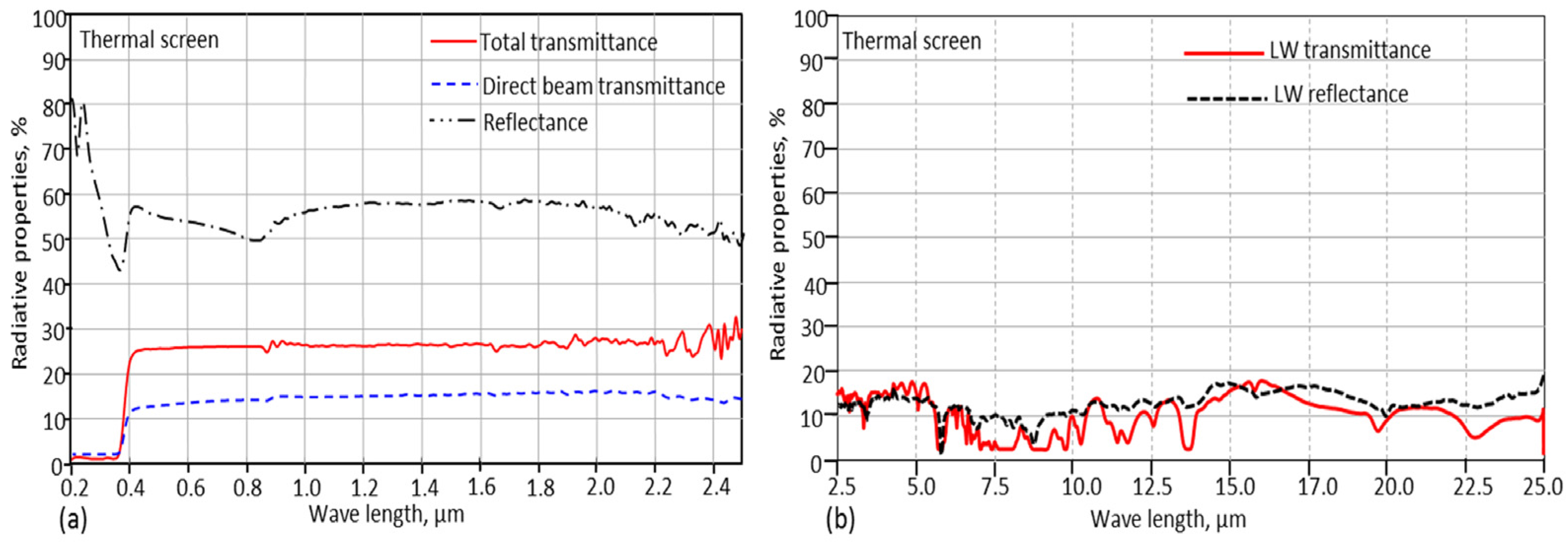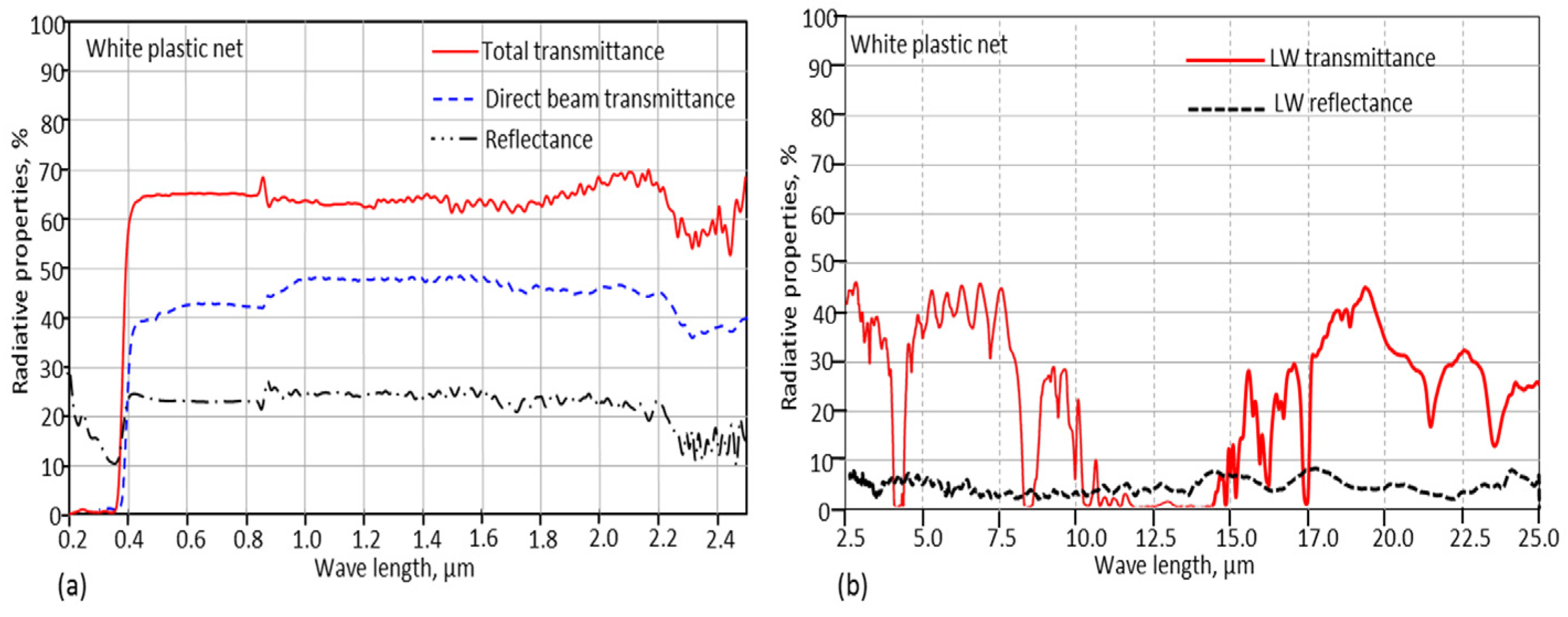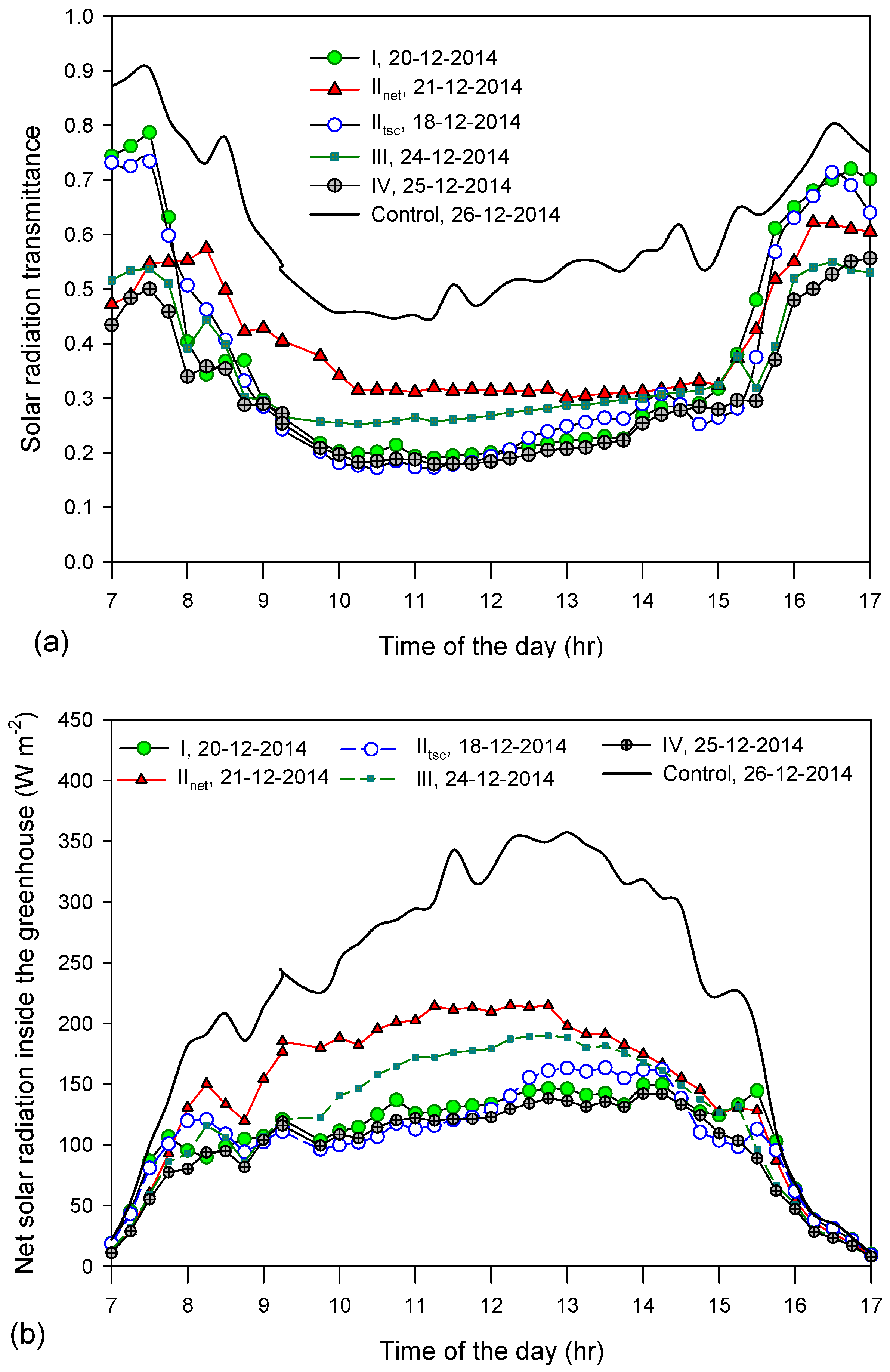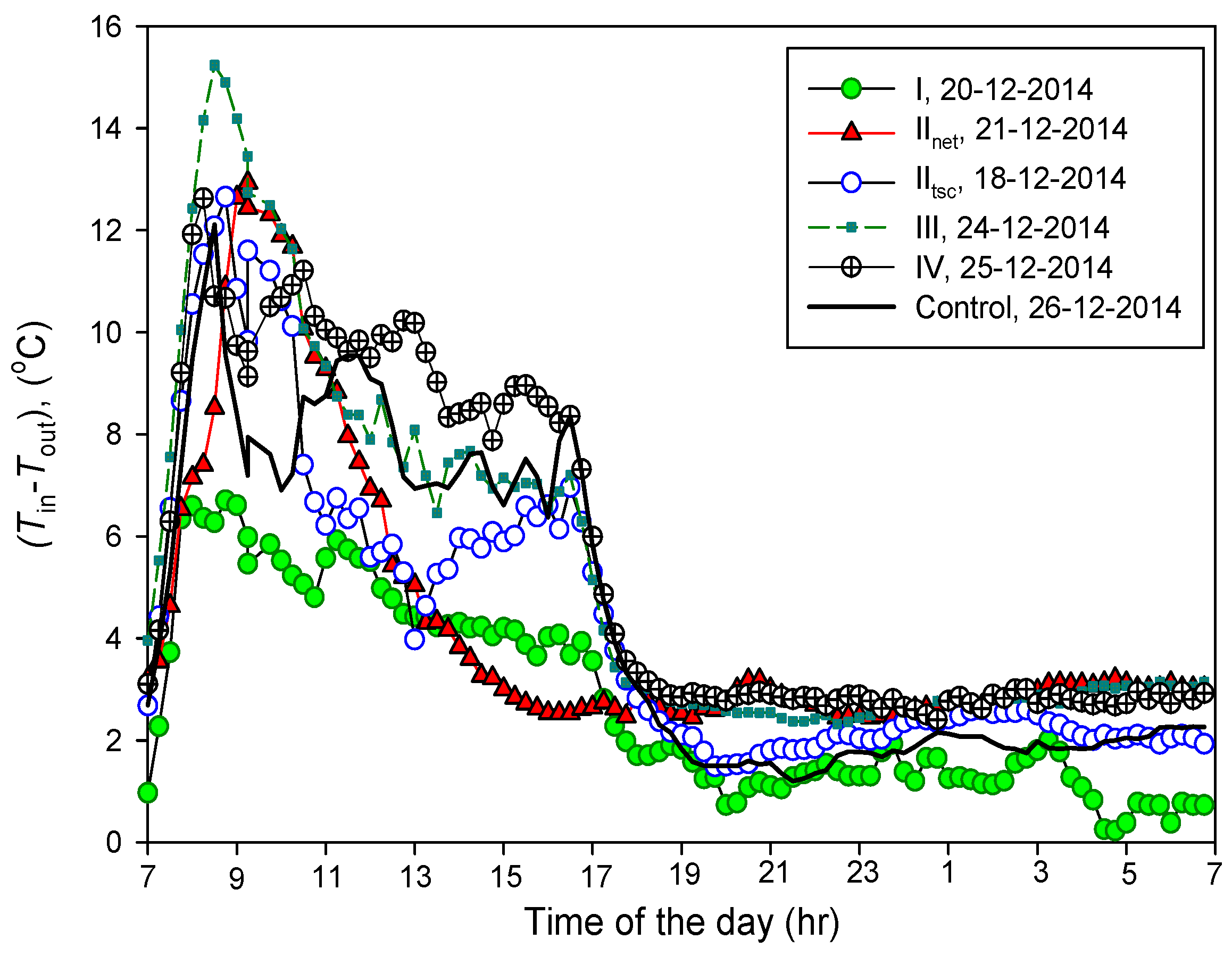Radiometric Characterization, Solar and Thermal Radiation in a Greenhouse as Affected by Shading Configuration in an Arid Climate
Abstract
:1. Introduction
2. Materials and Methods
2.1. Experimental Set-up and Shading Configuration
2.2. Measuring the Required Parameters

3. Results and Discussion




| Material | Range | Wavelength [nm] | Transmittance [%] | Reflectance [%] | Absorptance [%] | |
|---|---|---|---|---|---|---|
| Total | Direct | |||||
| Black plastic net | Global solar | 200–2500 | 27.9 | 26.1 | 3.5 | 68.6 |
| PAR | 400–700 | 27.5 | 26.6 | 3.7 | 68.8 | |
| IR-thermal | 7500–12500 | 23.2 | - | 0.9 | 75.9 | |
| White plastic net | Global solar | 200–2500 | 61.0 | 43.4 | 24.1 | 14.9 |
| PAR | 400–700 | 62.6 | 42.0 | 24.0 | 13.4 | |
| IR-thermal | 7500–12500 | 7.9 | - | 2.8 | 89.3 | |
| Thermal Screen | Global solar | 200–2500 | 26.1 | 13.4 | 55.2 | 18.7 |
| PAR | 400–700 | 26.3 | 12.8 | 55.4 | 18.3 | |
| IR-thermal | 7500–12500 | 4.7 | - | 8.7 | 86.6 | |
| Double-layer Pc sheet | Global solar | 200–2500 | 69.8 | 52.8 | 15.0 | 15.2 |
| PAR | 400–700 | 71.2 | 51.3 | 15.5 | 13.3 | |
| IR-thermal | 7500–12500 | 1.0 | - | 6.3 | 93.7 | |


| Shade designation | Net radiation (MJ m−2 day−1) | Radiation load | ||||
|---|---|---|---|---|---|---|
| Shading Description | Thermalday↓ | Thermalnight↑ | Solar day↓ | day↓ | night↑ | |
| I | External roof shading (black net), Figure 1a | 0.40 | 0.57 | 4.0 | 4.4 | 0.57 |
| IInet | Internal roof shading (white net), Figure 1b | 0.99 | 0.38 | 5.3 | 6.29 | 0.38 |
| IItsc | Internal roof shading (thermal screen), Figure 1b | 0.95 | 0.65 | 4.0 | 4.95 | 0.65 |
| III | Internal roof and side walls shading, Figure 1c | 1.26 | 0.50 | 4.5 | 5.76 | 0.50 |
| IV | External roof and internal side walls shading Figure 1d | 0.58 | 0.60 | 3.58 | 4.16 | 0.60 |
| Control | Without shading | 0.51 | 0.67 | 8.23 | 8.74 | 0.67 |

4. Conclusions
- The external roof-shading is the most desirable method, it reduced the generated thermal radiation in the greenhouse by 21% and 15% during the day and night times, respectively, and significantly reduced the greenhouse air temperature during the day time.
- With the external roof-shading, the required solar radiation in the greenhouse can be controlled by selecting a net with the desired shading factor.
- Internal shading (roof and side walls) is an undesirable method, since it drastically increases the generated thermal radiation in the greenhouse by 147% and strongly increases the greenhouse air temperature during the day.
- Shading the side-walls, externally or internally, is not recommended because it significantly reduces the transmitted solar radiation in the morning and afternoon (when the outside irradiance is low) and is useless around noon when the outside irradiance is extremely high.
Acknowledgments
Author Contributions
Conflicts of Interest
References
- Abdel-Ghany, A.M.; Al-Helal, I.M. Analysis of solar radiation transfer: A method to estimate the porosity of a plastic shading net. Energy Conver. Manag. 2011, 52, 341–346. [Google Scholar] [CrossRef]
- Abdel-Ghany, A.M.; Al-Helal, I.M.; El-zahrani, S.M.; Alsadon, A.A.; Ali, I.M.; Elleithy, R.M. Covering materials incorporating radiation-preventing techniques to meet greenhouse cooling challenge in arid regions: A review. Sci. World J. TSWJ 2012. [Google Scholar] [CrossRef]
- Castellano, S.; Scarascia, G.M.; Russo, G.; Briassoulis, D.; Mistriotis, A.; Hemming, S. Plastic nets in agriculture: A general review of types and applications. Appl. Eng. Agric. 2008, 24, 799–808. [Google Scholar] [CrossRef]
- Kittas, E.; Bartzanas, T.; Savvas, D.; Katsoulas, N. Effect of shading on greenhouse energy balance and crop transpiration. Acta Hortic. (ISHS) 2012, 927, 689–694. [Google Scholar] [CrossRef]
- Baille, A.; Kittas, C.; Katsoulas, N. Influence of whitening on greenhouse microclimate and crop energy portioning. Agric. Forest Meteorol. 2001, 107, 293–306. [Google Scholar] [CrossRef]
- Mashonjowa, E.; Ronsse, F.; Mhizha, T.; Milford, J.R.; Lemeur, R.; Pieters, J.G. The effects of whitening and dust accumulation on the microclimate and canopy behavior of rose plants (Rosa hybrida) in a greenhouse in Zimbabwe. Solar Energy 2010, 84, 10–23. [Google Scholar] [CrossRef]
- Willits, D.H. The effect of cloth characteristics on the cooling performance of external shade cloths for greenhouses. J. Agric. Eng. Res. 2001, 79, 331–340. [Google Scholar] [CrossRef]
- Willits, D.H. The effect of cloth temperature on the cooling efficiency of shade cloths in greenhouses. Trans. ASAE 2003, 46, 1215–1221. [Google Scholar] [CrossRef]
- Ghosal, M.K.; Tiwari, G.N.; Srivastava, N.S.L. Modeling and experimental validation of a greenhouse with evaporative cooling by moving water film over external shade cloth. Energy Build. 2003, 35, 843–850. [Google Scholar] [CrossRef]
- Vladimirova, S.V.; Bucklin, R.A.; McConnell, D.B. Influence of shade level, wind velocity, and wind direction on interior air temperature of model shade structures. Trans. ASAE 1996, 39, 1825–1830. [Google Scholar] [CrossRef]
- Soni, P.; Salokhe, V.M.; Tantau, H.J. Effect of screen mesh size on vertical temperature distribution in naturally ventilated tropical greenhouses. Biosyst. Eng. 2005, 92, 469–482. [Google Scholar] [CrossRef]
- Ali, H.M.; Moustafa, S.; El-Mansy, H. An efficient greenhouse design for hot climates. Energy Conver. Manag. 1990, 30, 433–437. [Google Scholar] [CrossRef]
- Kittas, C.; Rigakis, N.; Katsoulas, N.; Bartzanas, T. Influence of shading screens on microclimate, growth and productivity of tomato. Acta Hortic. (ISHS) 2009, 807, 97–102. [Google Scholar] [CrossRef]
- Harmanto, M.; Tantau, H.J.; Salokhe, V.M. Microclimate and air exchange rates in greenhouses covered with different nets in the humid tropics. Biosyst. Eng. 2006, 94, 239–253. [Google Scholar] [CrossRef]
- Al-Helal, I.M. Effects of ventilation rate on the environment of a fan-pad evaporatively cooled shaded greenhouse in extreme arid climates. Appl. Eng. Agric. 2007, 23, 221–230. [Google Scholar] [CrossRef]
- Sandri, M.A.; Andriolo, J.L.; Witter, M.; Dal Ross, T. Effect of shading on tomato plants grow under greenhouse. Hortic. Brasileira 2003, 21, 642–645. [Google Scholar] [CrossRef]
- Medany, A.M.; Hassanein, M.K.; Farag, A.A. Effect of black and white nets as alternative covers in sweet pepper production under greenhouses in Egypt. Acta Hortic. (ISHS) 2009, 807, 121–126. [Google Scholar] [CrossRef]
- Briassoulis, D.; Mistriotis, A.; Eleftherakis, D. Mechanical behavior and properties of agricultural nets—Part II: Analysis of the performance of the main categories of agricultural nets. Polym. Test. 2007, 26, 970–984. [Google Scholar] [CrossRef]
- Kim, G.; Lim, H.S.; Lim, T.S.; Schaefer, L.; Kim, J.T. Comparative advantage of an exterior shading device in thermal performance for residential buildings. Energy Build. 2012, 46, 105–111. [Google Scholar] [CrossRef]
- Kim, S.H.; Shin, K.J.; Choi, B.E.; Jo, J.H.; Cho, S.; Cho, Y.H. A study on the variation of heating and cooling load according to the use of horizontal shading and venetian blinds in office buildings in Korea. Energies 2015, 8, 1487–1504. [Google Scholar] [CrossRef]
- Huang, K.T.; Liu, K.F.R.; Liang, H.H. Design and energy performance of a buoyancy driven exterior shading device for building application in Taiwan. Energies 2015, 8, 2358–2380. [Google Scholar] [CrossRef]
- Picuno, P. Innovative material and improved technical design for a sustainable exploitation of agricultural plastic film. Polym.-Plastics Tech. Eng. 2014, 53, 1000–1011. [Google Scholar] [CrossRef]
- Sethi, V.P.; Dubey, R.K.; Dhath, A.S. Design and evaluation of modified screen net house for off-season vegetable raising in composite climate. Energy conver. Manag. 2009, 50, 3112–3128. [Google Scholar] [CrossRef]
- Schettini, E.; De Salvador, F.R.; Scarascia-Mugnozza, G.; Vox, G. Evaluation of colored nets in peach protected cultivation. Acta Hortic. (ISHS) 2011, 893, 235–242. [Google Scholar] [CrossRef]
- Sica, C.; Picuno, P. Spectro-radiometrical characterization of plastic nets for protected cultivation. Acta Hortic. (ISHS) 2008, 801, 245–252. [Google Scholar] [CrossRef]
- Al-Helal, I.M.; Abdel-Ghany, A.M. Measuring and evaluating solar radiative properties of plastic shading nets. Sol. Energy Mater. Sol. Cells 2011, 95, 677–683. [Google Scholar] [CrossRef]
- Abdel-Ghany, A.M.; Kozai, T. On the determination of the overall heat transmission coefficient and soil heat flux for a fog-cooled, naturally ventilated greenhouse: analysis of radiation and convection heat transfer. Energy Conver. Manag. 2006, 47, 2612–2628. [Google Scholar] [CrossRef]
- Abdel-Ghany, A.M.; Kozai, T.; Chun, C. Evaluation of selected greenhouse covers for use in regions with a hot climate. Jpn. J. Tropic. Agric. 2001, 45, 242–250. [Google Scholar]
- He, L.; Short, T.H.; Yang, X. Solar radiation transmittance of a double-walled acrylic pellet insulated greenhouse. Trans. ASAE 1991, 34, 2559–2563. [Google Scholar] [CrossRef]
© 2015 by the authors; licensee MDPI, Basel, Switzerland. This article is an open access article distributed under the terms and conditions of the Creative Commons by Attribution (CC-BY) license (http://creativecommons.org/licenses/by/4.0/).
Share and Cite
Abdel-Ghany, A.M.; Picuno, P.; Al-Helal, I.; Alsadon, A.; Ibrahim, A.; Shady, M. Radiometric Characterization, Solar and Thermal Radiation in a Greenhouse as Affected by Shading Configuration in an Arid Climate. Energies 2015, 8, 13928-13937. https://doi.org/10.3390/en81212404
Abdel-Ghany AM, Picuno P, Al-Helal I, Alsadon A, Ibrahim A, Shady M. Radiometric Characterization, Solar and Thermal Radiation in a Greenhouse as Affected by Shading Configuration in an Arid Climate. Energies. 2015; 8(12):13928-13937. https://doi.org/10.3390/en81212404
Chicago/Turabian StyleAbdel-Ghany, Ahmed M., Pietro Picuno, Ibrahim Al-Helal, Abdullah Alsadon, Abdullah Ibrahim, and Mohamed Shady. 2015. "Radiometric Characterization, Solar and Thermal Radiation in a Greenhouse as Affected by Shading Configuration in an Arid Climate" Energies 8, no. 12: 13928-13937. https://doi.org/10.3390/en81212404







